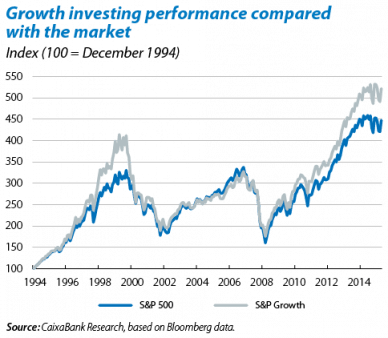One major goal of all stock market investors is to outperform the market but without taking on more risk than the risk entailed in investing in that representative basket of assets. One strategy that has shown itself to be effective in this respect is value investing (see the Focus «The real value of value investing» in MR03/2016). Another strategy, growth investing, is related to the investment approach of Thomas Rowe Price, the founder, in 1937, of the management firm that still bears his name.
Growth investing focuses on companies with high potential growth in earnings. In contrast with the strategy of value investing, it tends to ignore the shares of mature companies with moderate growth figures in sales or earnings, although these may be undervalued. A growth portfolio tends to contain mostly shares from innovative industries with high technological component (information technologies, biotechnology, etc.). In many cases these are young or relatively small firms that do not pay out dividends, either because they are still in an initial phase and do not make a profit or because they reinvest in order to continue growing. The nature of these companies is partly the reason why they offer higher returns than the market average: small firms are less covered by specialised analysts and high growth rates in earnings tend to result in higher uncertainty (or less precision) in their estimates. Given this situation, investors demand a higher risk premium.
Assets for a growth investing portfolio can be chosen based on various criteria. The simplest would consist of buying shares with a relatively high P/E ratio (price to earnings), reflecting the expectation of strong growth in profits. Empirical evidence suggests caution, however, as companies with high P/E ratios tend to perform worse than those with low P/E ratios. An alternative focus consists of identifying shares with a recent history (or with projections, either the investor's own or a third party's) of high growth in earnings. Nevertheless, basing a decision on past growth always involves the risk that the future may not be as brilliant while trusting in projections entails the cost of the resources required to make such forecasts or to evaluate the quality of the predictions made by others. A third criterion is a mix of the previous two; selecting companies that are expected to achieve large profits in relation to their P/E ratio (the quotient between these two figures is called the price/earnings to growth or PEG ratio). This criterion, known as the GARP strategy (growth at reasonable price) and combining aspects of value and growth investing, was popularised by Peter Lynch, the legendary investor at Fidelity.
There are currently several indices that are considered to represent the features of growth investing in accordance with some of the simple criteria mentioned (and therefore a somewhat rough approximation of the strategy). For example, the S&P 500 Growth in the US stock market, which contains a sub-set of shares on the S&P 500 (on average its shares currently have a P/E ratio of 22 compared with 19 for the S&P 500). The annual return of the S&P 500 Growth in the last 10 years (6.1%) exceeds that of the index as a whole by almost 2 pps.
Various academic studies have investigated the results of this strategy more thoroughly. Damodaran,1 for example, concludes that a growth investing strategy can provide returns above the market average especially when the investment horizon is long and the timing for buying and selling shares is well-chosen. In any case the results achieved tend to be worse than those via a value investing strategy. Empirical evidence indicates that the best time to invest in growth coincides with downward phases in the economic cycle, partly because the profits from this kind of companies are less correlative with the cycle and also because, in a weakening context, investors seem to suffer from excessive scepticism regarding the prospects of such firms.
Growth investing, however, also entails significant risks. In particular this kind of firms are more prone to generate bubbles (such as the tech rally) or to suffer from strong losses in a highly unstable environment (such as the financial crisis of 2008-2009). A reminder of the wisdom of maintaining a suitably diversified portfolio.
1. Damodaran, A. (2012), «Growth Investing: Betting on the Future?», New York University, 27 July.



